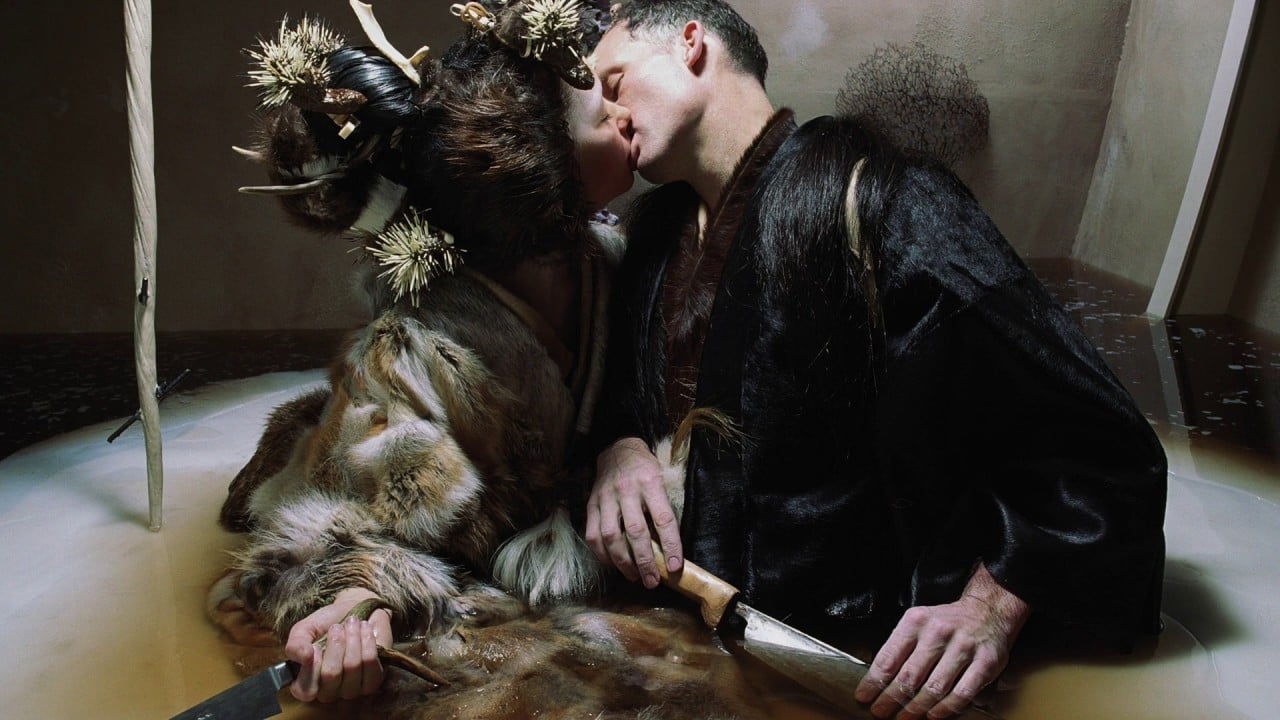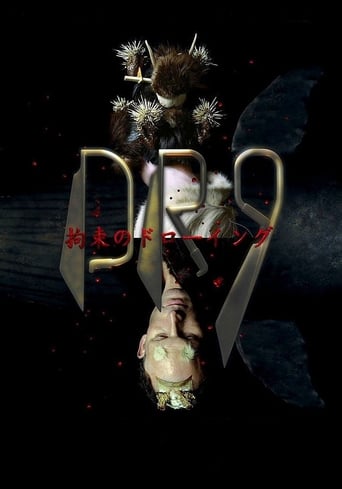

Matthew Barney is the Lance Armstrong of contemporary art. In my opinion, no chef can yet lay claim to this position. Drawing Restraint 9 is also the best food-related film ever made, a lavish display of sensuality and ritual.Drew Daniel of Matmos wrote this stellar description of Barney's art practice on Björk's DR9 website: Barney is a visual artist whose ambitious, rigorous multimedia work encodes esoteric meanings while providing lushly immediate aesthetic rewards. Best known for The Cremaster Cycle, the sprawling sequence of five films made over ten years which was the subject of a recent Guggenheim retrospective, Matthew Barney's work is multimedia in execution but singularly focused in conception: tightly unified fusions of sculpture, performance, architecture, set design, music, computer generated effects and prosthetics, Barney's films deploy the full range of cinematic resources in the service of a hermetic vision rich with densely layered networks of meaning drawn from mythology, history, sports, music, and biology.This is a sexy way of saying that Barney's work is based upon his own elaborate and logical cosmology. In Drawing Restraint he playfully turns materials, forms, geometries and processes (e.g. petroleum jelly, silicone, whale blubber, ambergris, other marine excretions and accretions), cultural-historical narratives and geographic trajectories (e.g. the architecture, interior and machinery of a whaling ship, the culture of whaling, the history of a specific ship) and the experience of time (e.g. pearl oyster divers holding their breath under water, the migration of whales, a Japanese tea ceremony), into a luscious weave of deeply connected meaning and narrative.This is where chefs tend to slack off.But this is Barney's demarrage, an escape or breakaway that gives him an advantage over the rest of the 'field'. Whereas it is common for a chef to create a 'richly organized set of aesthetics' (as Drew Daniel describes Barney's approach to making art), I know of no example within the culture of contemporary haute cuisine in which a chef contextualizes elements on this level to form a total experience beyond the formal boundaries of restaurant culture. Perhaps I'm not going to the right sort of parties. I long for an haute cuisine that is less 'applied' and more autonomous.The film has as its theme, the relationship between the self-imposed resistance and the trans-formative creativity inherent in the artistic process. I offer a simplified (flattened) overview of the narrative to suggest why this film is food-related, and a plea to the chefs of the world to step up their efforts and move towards creative autonomy.
... View MoreIt you are Japanese or know something about Japanese mythology and/or whaling culture in japan, then this movie will mean a lot more to you than others. I know most people who watch this movie will come out of the theater ferociously hating Matthew Barney and be turned off of modern art, but for me, this movie was grounded in ancient Japanese traditions. And to have witnessed it, even if it is bastardized from it's Japanese roots, is a fortunate event. I'll attempt to write the plot as I saw it. Barney and Bjork were invited onto the whaling vessel as guests. They begin their journey by transforming into sea spirits through several elaborate and beautiful (however long and confusing) ceremonies and rites of passages . This all happens while the whaling crew perform their duties on the symbolic whale. In the end the journey takes a gruesome turn and the transformation is complete. This is by no means an easy movie to sit through, be forewarned. However, I believe the value is in your furthered exploration into the subject of Japanese culture, ritual and mythology. Be sure to check out the exhibit at your local museum if it comes to your town. It is absolutely amazing to see.
... View MoreThis has got to be one of the worst movies I've ever seen! There were people leaving the theatre, others were falling asleep (ok, it was a late night show)... This is a no-sense movie, one of those who can make you never want to see an out of mainstream picture again. I would love to watch the making-off of this movie as I am deeply interested on what goes on the minds of the authors of such garbage. Do they laugh when they create all this ridiculous stuff or do they actually think they're doing something interesting? I wonder... The soundtrack is awful apart from some instrumental stuff that reminds you of a previous Bjork album. Even if you're a fan of Bjork's music, stay home. It's the best thing to do. The little, tiny, pieces of nice music are no reason for you to go out and submit yourself to this torture. God!...
... View MoreLast night I went to the movies; saw Drawing Restraint 9, a new film by Matthew Barney and featuring Bjork. I don't go to a lot of movies, but when I left this one I was convinced that I had not gone to a movie at all, but participated in an ancient magical rite having nothing to so with modern movie making.While definitely not a Hollywood feature, it was nevertheless described in the usual hyperbole put out by the theatrical machine conglomerates: "Mesmerizing Viewing, Amazingly Beautiful, Startling Wit and Invention." Of course it was all of the above, but what I saw and experienced in the movie theater was something more than that; something else altogether, the telling without words and reconstruction of an ancient primeval theater that can only be entered by instinct and non-human intelligence.Most of the action takes place aboard ship. On board a Japanese whaling vessel two occidental guests (Barney and Bjork) are invited aboard to share in a formal tea ceremony with the captain. First they are dressed in elaborate wedding clothes inspired by Shinto marriage rites, because after the ceremony they will emerge themselves in a kiss that not only unites the two in a limited matrimony, but also reunites them with the greater sea.I'm not even sure if this was a movie; perhaps it was an actual documentary constructed around the performance of some long forgotten ancient religious ritual, being remembered just now with the help of modern awareness that media affords, like the telescope aided Galileo in redefining the heavens. Yet I do not think the hundreds of "extras" were privy to any of this.And I should make it clear that the extras weren't really extras at all -- they were the actual crew members who live aboard ship. What Barney and Bjork have done, in my estimation, was commandeered the ship and held the captain and crew hostage -- with their permission of course, while pretending to star in a movie -- and then initiated the ancient rites recently remembered by the Icelandic Bjork.But of course the millions of dollars that this all must have cost would've produced one hell of a Hollywood blockbuster! Yet for Bjork and Barney it is an extremely limited engagement that will disappear within a week of its showing. For them the rewards will have been recognized instantly, not in box office dollars but in a newer awareness that an old universe continually demands of its inhabitants.The soundtrack is made of songs, chants and primeval sounds dispersed throughout the movie, which on another level act as incantations spoken directly to Nature, to reverse the direction of Art, specifically the Art of the Whaling Ship. This is hinted at when Bjork and Barney go through an amazing transformation at the close of the film, transforming themselves into whales, complete with blowholes, and return to the sea from which we were all plucked in our infancy.Further indication that this "movie" is really a magical rite in which we are all invited to take part is the captain's short telling of the history of the ship, how it suffered a slight scar at sea (being rammed by another ship), a scar which is now etched on the memory of the crew. "But there is a much older story within the deeper scar." The captain and his occidental guests tell that story to us, through the traditional Japanese tea ceremony wherein they drink of a mixture infused from of the "magnificent ambergris that was once passed through the whale" and the subsequent marriage vows by which the guests cut away superfluous limbs and prepare themselves for their voyage back to the sea, where ceremony once again takes on the fluidity of life.There are additional insights from Bjork's sparsely sung sound track. Utilizing the essential sounds from the ocean and the life in, around, and aboard the ship, she whispers in places the ancient formula of creation: From the moment of commitment, Nature conspires to help us. It is the old Christian aphorism, "All things are provided when we first seek the Kingdom of Heaven." Or Hell, if you prefer.In truth I believe this movie was conceived as ritual, performed by devout and honest people who were not acting (only accentuating and theatricalizing their normal activities) but ultimately redirecting the energies of nature towards the ending of a cruel and unusual punishment still being practiced on one of the great and magnificent life forms that welcomed us aboard in the first place.Possibly tedious at some points, I thought it was equally wonderful that Bjork and Matthew and the Captain and crew had so much leisure to be able to tell the story, to act in this way, to live for weeks or months on the ship and its legacy. But then, I'm a full time artist who has no idea what time it is.What was happening on the screen was only a key meant to unlock what has always been happening within us, within the deeper scar from which we all are naturally and continually emerging our being.Warning: Don't go see this movie with an audience who expected to go see a movie. Buy the DVD instead and follow the instructions, safely inside the privacy of your own home.
... View More